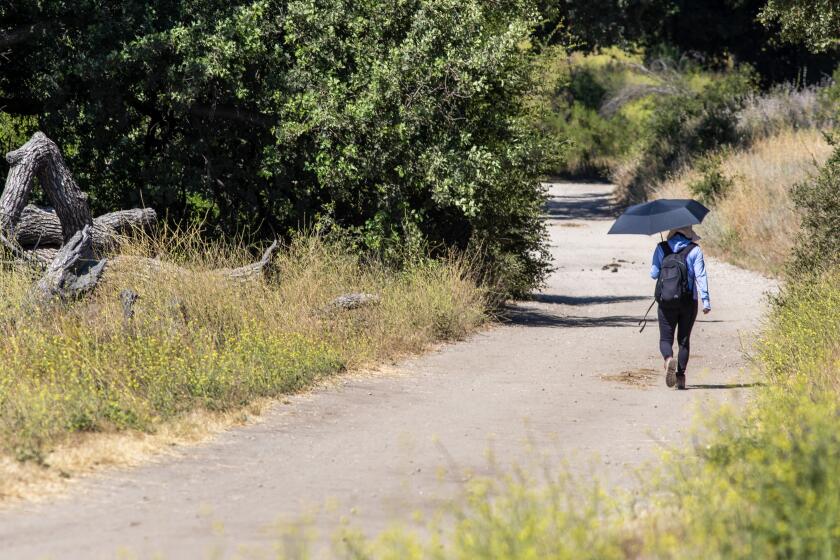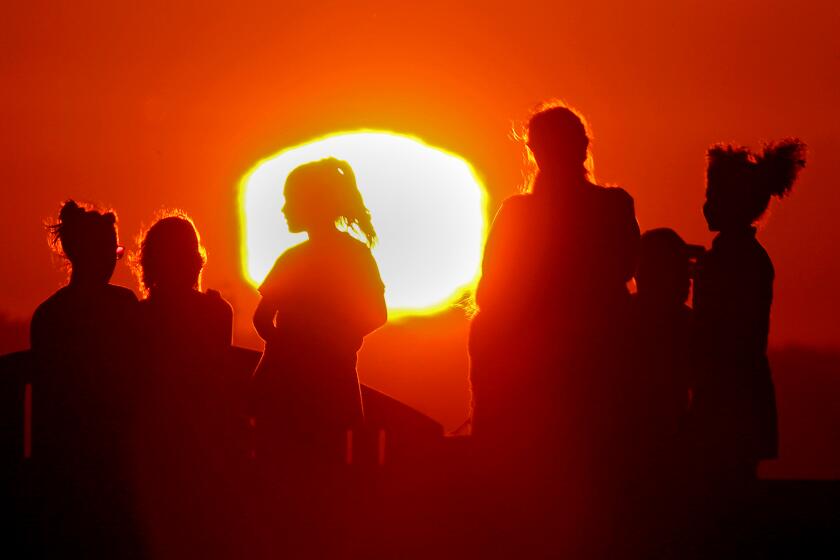What can make a difference between life and death during a heat wave

- Share via
Weather forecasts have gotten quite good over the years, but their temperatures aren’t always spot on — and the result when they underplay extremes can be lethal. Even a 1-degree difference in a forecast’s accuracy can be the difference between life and death, our research shows.
As economists, we have studied how people use forecasts to manage weather risks. In a new working paper for the National Bureau of Economic Research, we looked at how human survival depends on the accuracy of temperature forecasts, particularly during heat waves like large parts of the U.S. have been experiencing in recent days.
We found that when the weather forecasts underplayed the risk, even small forecast errors led to more deaths.
Our results also show that making forecasts 50% more accurate would save 2,200 lives per year across the country and would have a net value that’s nearly twice the annual budget of the National Weather Service.
In the U.S. alone, the National Oceanic and Atmospheric Administration issues 1.5 million forecasts per year. We examined data on each day’s deaths, weather and National Weather Service forecast in every U.S. county from 2005 to 2017 to analyze the impact of those forecasts on human survival.
A heat wave is expected to hit Southern California this week, bringing ‘elevated’ fire danger to the region and increasing the chance for heat-related illness.
We then compared deaths in each county over the week following a day with accurate forecasts to deaths in the same county over the week following a day with inaccurate forecasts but the same weather. Because weather conditions were the same, any differences in mortality could be attributed to how people’s reactions to forecasts affected their chance of dying in that weather.
We found similar results when the forecast was wrong on hot days with temperatures above 86 degrees Fahrenheit and on cold days with temperatures below freezing. Summer days that were hotter than forecast and winter days that were colder than predicted had more deaths. Yet forecasts that overestimated the summer heat or winter cold had little impact.
The fact is, people do pay attention to weather forecasts and adjust their activities in response to them. We found that on days when the forecast called for temperatures to be milder than they turned out to be — either cooler on a hot day or warmer on a cold day — people spent more time on leisure and less in home or work settings.
Electricity use also varies in sync with forecasts, suggesting that people’s use of air conditioning does not just respond to the weather outside but also on how they planned for the weather outside.
However, weather forecasts are not used equally across society. Deaths among racial minorities are less sensitive to forecast errors, we found. That could be due in part to having less flexibility to act on forecasts, or not having access to them.
It’s clear that people use weather forecasts to make decisions that can matter for life and death — when to go hiking, for example, or whether to encourage an elderly neighbor to go to a cooling center.
So, what is the value of accurate weather forecasts?
California’s first heat wave of the year could last into next week. Here are some tips on how to stay safe and cool during hot weather.
We used federal cost-benefit estimates of how people value improvements in their chances of survival to estimate their willingness to pay for better forecasts.
The result shows that 50% more accurate forecasts are worth at least $2.1 billion per year based on the mortality benefits alone. In comparison, the 2022 budget of the National Weather Service was less than $1.3 billion.
Weather forecasts have gotten steadily better over the past decades. About 68% of the next-day temperature forecasts now have an error of less than 1.8 degrees. Our results suggest investing in improved forecast accuracy would be worth the cost. Past improvements have come from better models, observations and computers. Future improvements could come from similar channels and from applying recent innovations in machine learning and artificial intelligence to weather prediction and communication.
The frequency of extremely hot days is increasing due to climate change, making more accurate weather forecasts even more important for human health and survival. Our weather is getting weirder, but weird weather can do less harm when we can see it coming.
Derek Lemoine is a professor of economics in the Eller College of Management at the University of Arizona. Jeff Shrader is an assistant professor at the School of International and Public Affairs at Columbia University. Laura Bakkensen is an associate professor of economics and policy at the University of Arizona’s School of Government and Public Policy. This article was produced in partnership with The Conversation.
More to Read
A cure for the common opinion
Get thought-provoking perspectives with our weekly newsletter.
You may occasionally receive promotional content from the Los Angeles Times.











